Human Resource Management Report: Essential HR Metrics Analysis
VerifiedAdded on 2022/09/09
|7
|1512
|8
Report
AI Summary
This report analyzes the significance of HR metrics for benchmarking and evaluating the value of human resource initiatives. It emphasizes the need for selecting and tracking key metrics, such as resignation rate, absenteeism rate, external offer acceptance rate, vacancy rate, succession planning rate, promotion rate, labor cost to revenue ratio, employee happiness/job satisfaction, training expenses per worker, and talent turnover rate. The report highlights the importance of customizing metrics to the specific business type and provides insights to help HR professionals make informed decisions based on reliable data and best practices, ultimately enhancing talent management and organizational performance. The report provides a comprehensive overview of each metric, its significance, and how it can be used for benchmarking against similar businesses. The report is supported by references from major HR organizations across Canada, providing a deep validation of the information provided.
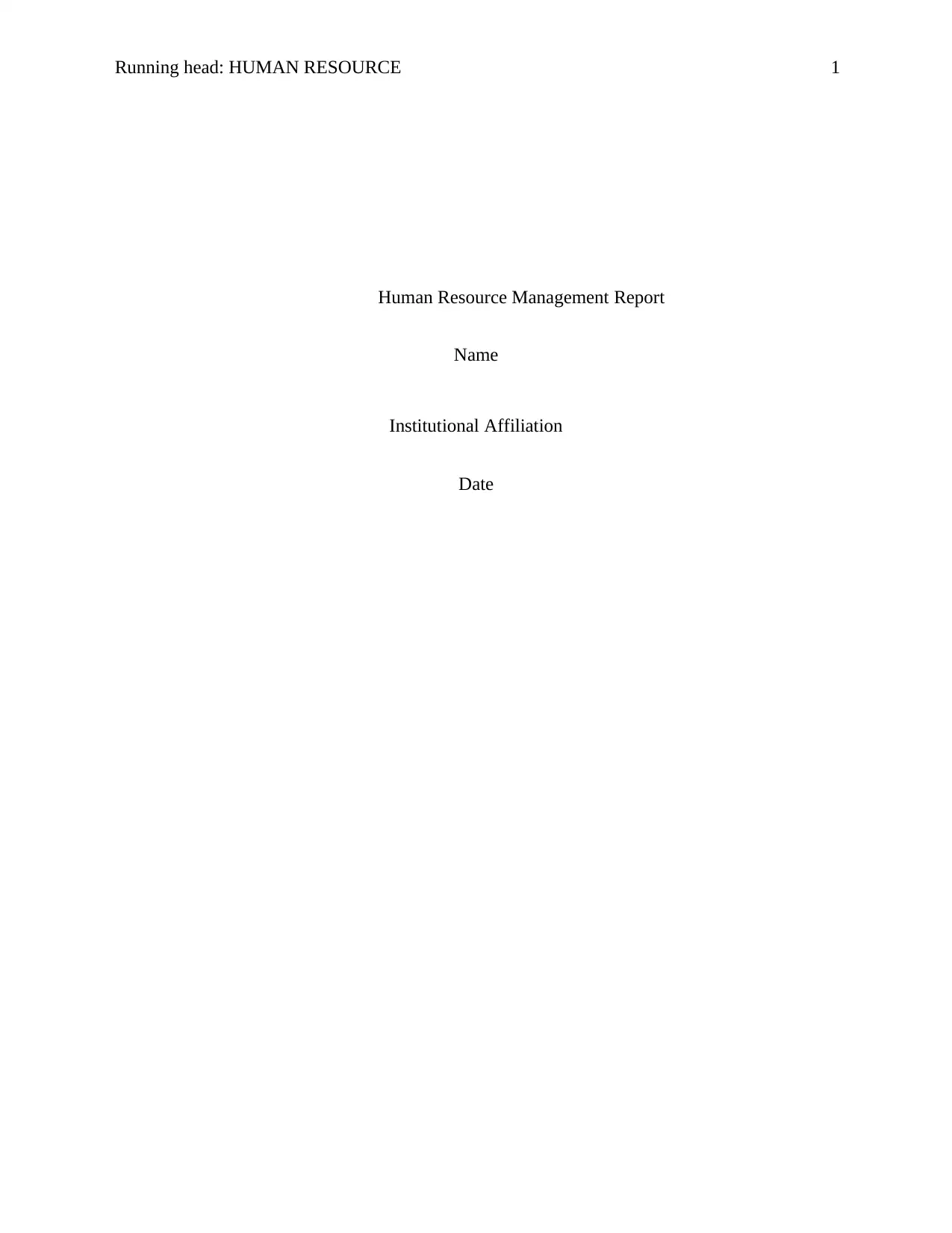
Running head: HUMAN RESOURCE 1
Human Resource Management Report
Name
Institutional Affiliation
Date
Human Resource Management Report
Name
Institutional Affiliation
Date
Paraphrase This Document
Need a fresh take? Get an instant paraphrase of this document with our AI Paraphraser
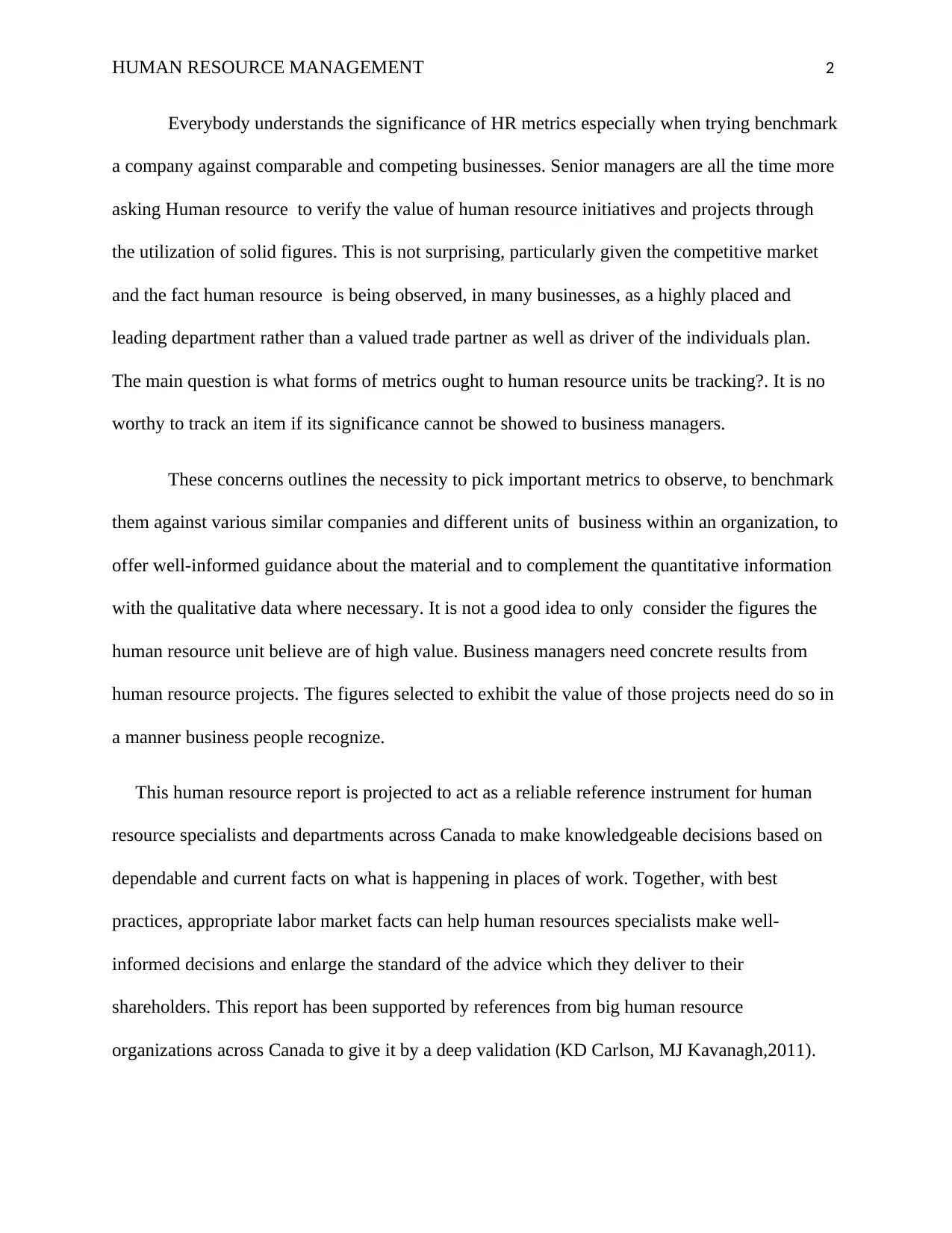
HUMAN RESOURCE MANAGEMENT 2
Everybody understands the significance of HR metrics especially when trying benchmark
a company against comparable and competing businesses. Senior managers are all the time more
asking Human resource to verify the value of human resource initiatives and projects through
the utilization of solid figures. This is not surprising, particularly given the competitive market
and the fact human resource is being observed, in many businesses, as a highly placed and
leading department rather than a valued trade partner as well as driver of the individuals plan.
The main question is what forms of metrics ought to human resource units be tracking?. It is no
worthy to track an item if its significance cannot be showed to business managers.
These concerns outlines the necessity to pick important metrics to observe, to benchmark
them against various similar companies and different units of business within an organization, to
offer well-informed guidance about the material and to complement the quantitative information
with the qualitative data where necessary. It is not a good idea to only consider the figures the
human resource unit believe are of high value. Business managers need concrete results from
human resource projects. The figures selected to exhibit the value of those projects need do so in
a manner business people recognize.
This human resource report is projected to act as a reliable reference instrument for human
resource specialists and departments across Canada to make knowledgeable decisions based on
dependable and current facts on what is happening in places of work. Together, with best
practices, appropriate labor market facts can help human resources specialists make well-
informed decisions and enlarge the standard of the advice which they deliver to their
shareholders. This report has been supported by references from big human resource
organizations across Canada to give it by a deep validation (KD Carlson, MJ Kavanagh,2011).
Everybody understands the significance of HR metrics especially when trying benchmark
a company against comparable and competing businesses. Senior managers are all the time more
asking Human resource to verify the value of human resource initiatives and projects through
the utilization of solid figures. This is not surprising, particularly given the competitive market
and the fact human resource is being observed, in many businesses, as a highly placed and
leading department rather than a valued trade partner as well as driver of the individuals plan.
The main question is what forms of metrics ought to human resource units be tracking?. It is no
worthy to track an item if its significance cannot be showed to business managers.
These concerns outlines the necessity to pick important metrics to observe, to benchmark
them against various similar companies and different units of business within an organization, to
offer well-informed guidance about the material and to complement the quantitative information
with the qualitative data where necessary. It is not a good idea to only consider the figures the
human resource unit believe are of high value. Business managers need concrete results from
human resource projects. The figures selected to exhibit the value of those projects need do so in
a manner business people recognize.
This human resource report is projected to act as a reliable reference instrument for human
resource specialists and departments across Canada to make knowledgeable decisions based on
dependable and current facts on what is happening in places of work. Together, with best
practices, appropriate labor market facts can help human resources specialists make well-
informed decisions and enlarge the standard of the advice which they deliver to their
shareholders. This report has been supported by references from big human resource
organizations across Canada to give it by a deep validation (KD Carlson, MJ Kavanagh,2011).
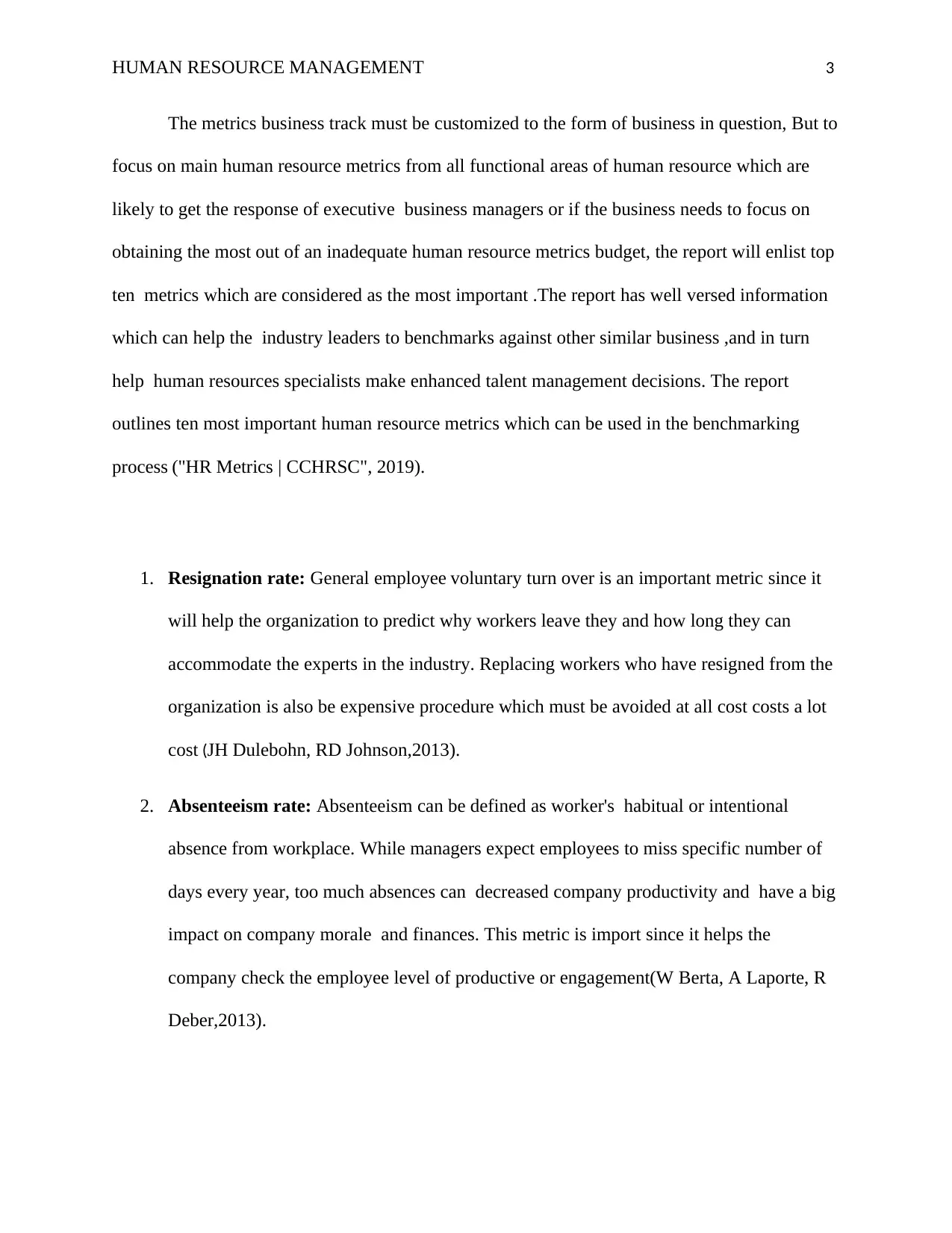
HUMAN RESOURCE MANAGEMENT 3
The metrics business track must be customized to the form of business in question, But to
focus on main human resource metrics from all functional areas of human resource which are
likely to get the response of executive business managers or if the business needs to focus on
obtaining the most out of an inadequate human resource metrics budget, the report will enlist top
ten metrics which are considered as the most important .The report has well versed information
which can help the industry leaders to benchmarks against other similar business ,and in turn
help human resources specialists make enhanced talent management decisions. The report
outlines ten most important human resource metrics which can be used in the benchmarking
process ("HR Metrics | CCHRSC", 2019).
1. Resignation rate: General employee voluntary turn over is an important metric since it
will help the organization to predict why workers leave they and how long they can
accommodate the experts in the industry. Replacing workers who have resigned from the
organization is also be expensive procedure which must be avoided at all cost costs a lot
cost (JH Dulebohn, RD Johnson,2013).
2. Absenteeism rate: Absenteeism can be defined as worker's habitual or intentional
absence from workplace. While managers expect employees to miss specific number of
days every year, too much absences can decreased company productivity and have a big
impact on company morale and finances. This metric is import since it helps the
company check the employee level of productive or engagement(W Berta, A Laporte, R
Deber,2013).
The metrics business track must be customized to the form of business in question, But to
focus on main human resource metrics from all functional areas of human resource which are
likely to get the response of executive business managers or if the business needs to focus on
obtaining the most out of an inadequate human resource metrics budget, the report will enlist top
ten metrics which are considered as the most important .The report has well versed information
which can help the industry leaders to benchmarks against other similar business ,and in turn
help human resources specialists make enhanced talent management decisions. The report
outlines ten most important human resource metrics which can be used in the benchmarking
process ("HR Metrics | CCHRSC", 2019).
1. Resignation rate: General employee voluntary turn over is an important metric since it
will help the organization to predict why workers leave they and how long they can
accommodate the experts in the industry. Replacing workers who have resigned from the
organization is also be expensive procedure which must be avoided at all cost costs a lot
cost (JH Dulebohn, RD Johnson,2013).
2. Absenteeism rate: Absenteeism can be defined as worker's habitual or intentional
absence from workplace. While managers expect employees to miss specific number of
days every year, too much absences can decreased company productivity and have a big
impact on company morale and finances. This metric is import since it helps the
company check the employee level of productive or engagement(W Berta, A Laporte, R
Deber,2013).
⊘ This is a preview!⊘
Do you want full access?
Subscribe today to unlock all pages.

Trusted by 1+ million students worldwide
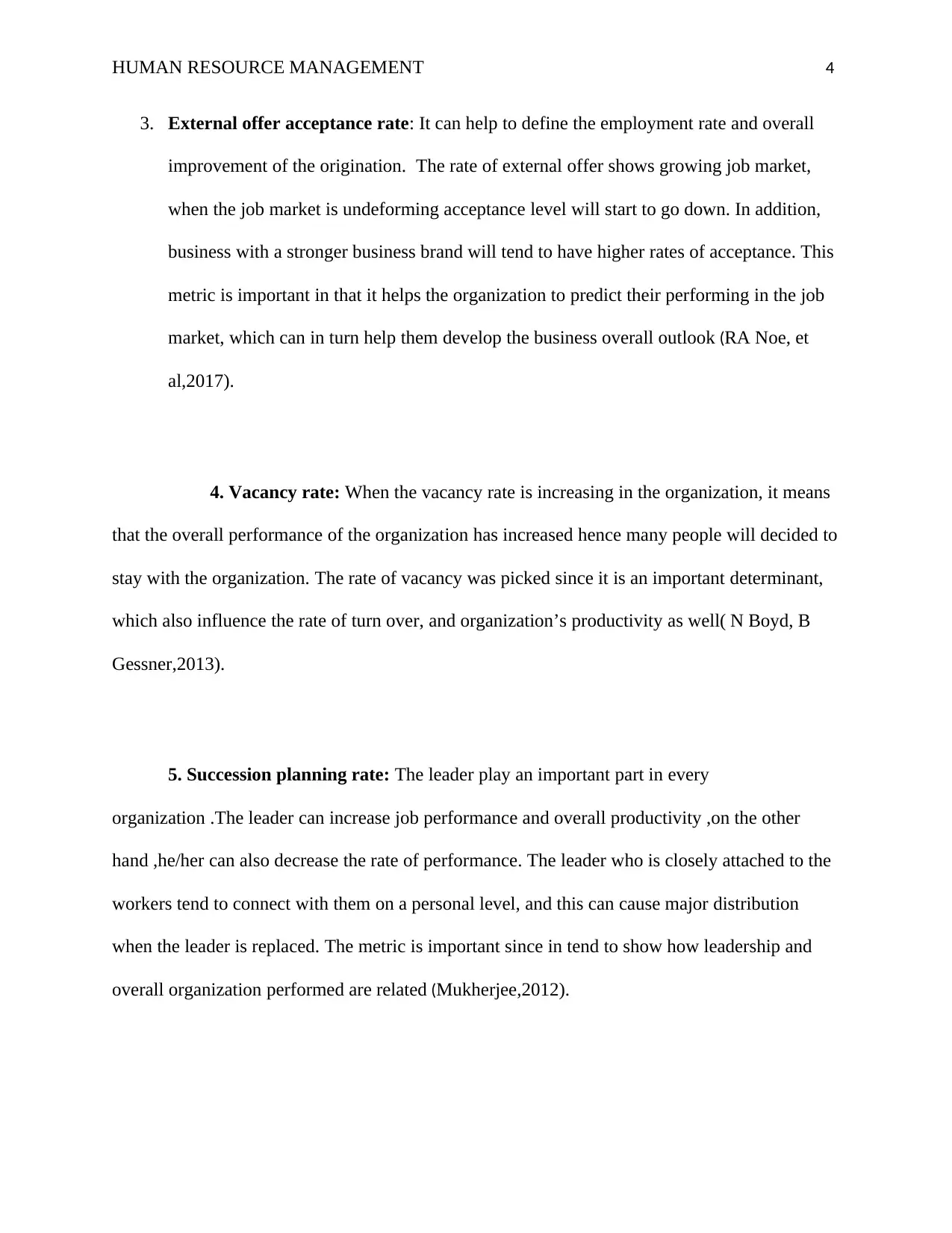
HUMAN RESOURCE MANAGEMENT 4
3. External offer acceptance rate: It can help to define the employment rate and overall
improvement of the origination. The rate of external offer shows growing job market,
when the job market is undeforming acceptance level will start to go down. In addition,
business with a stronger business brand will tend to have higher rates of acceptance. This
metric is important in that it helps the organization to predict their performing in the job
market, which can in turn help them develop the business overall outlook (RA Noe, et
al,2017).
4. Vacancy rate: When the vacancy rate is increasing in the organization, it means
that the overall performance of the organization has increased hence many people will decided to
stay with the organization. The rate of vacancy was picked since it is an important determinant,
which also influence the rate of turn over, and organization’s productivity as well( N Boyd, B
Gessner,2013).
5. Succession planning rate: The leader play an important part in every
organization .The leader can increase job performance and overall productivity ,on the other
hand ,he/her can also decrease the rate of performance. The leader who is closely attached to the
workers tend to connect with them on a personal level, and this can cause major distribution
when the leader is replaced. The metric is important since in tend to show how leadership and
overall organization performed are related (Mukherjee,2012).
3. External offer acceptance rate: It can help to define the employment rate and overall
improvement of the origination. The rate of external offer shows growing job market,
when the job market is undeforming acceptance level will start to go down. In addition,
business with a stronger business brand will tend to have higher rates of acceptance. This
metric is important in that it helps the organization to predict their performing in the job
market, which can in turn help them develop the business overall outlook (RA Noe, et
al,2017).
4. Vacancy rate: When the vacancy rate is increasing in the organization, it means
that the overall performance of the organization has increased hence many people will decided to
stay with the organization. The rate of vacancy was picked since it is an important determinant,
which also influence the rate of turn over, and organization’s productivity as well( N Boyd, B
Gessner,2013).
5. Succession planning rate: The leader play an important part in every
organization .The leader can increase job performance and overall productivity ,on the other
hand ,he/her can also decrease the rate of performance. The leader who is closely attached to the
workers tend to connect with them on a personal level, and this can cause major distribution
when the leader is replaced. The metric is important since in tend to show how leadership and
overall organization performed are related (Mukherjee,2012).
Paraphrase This Document
Need a fresh take? Get an instant paraphrase of this document with our AI Paraphraser
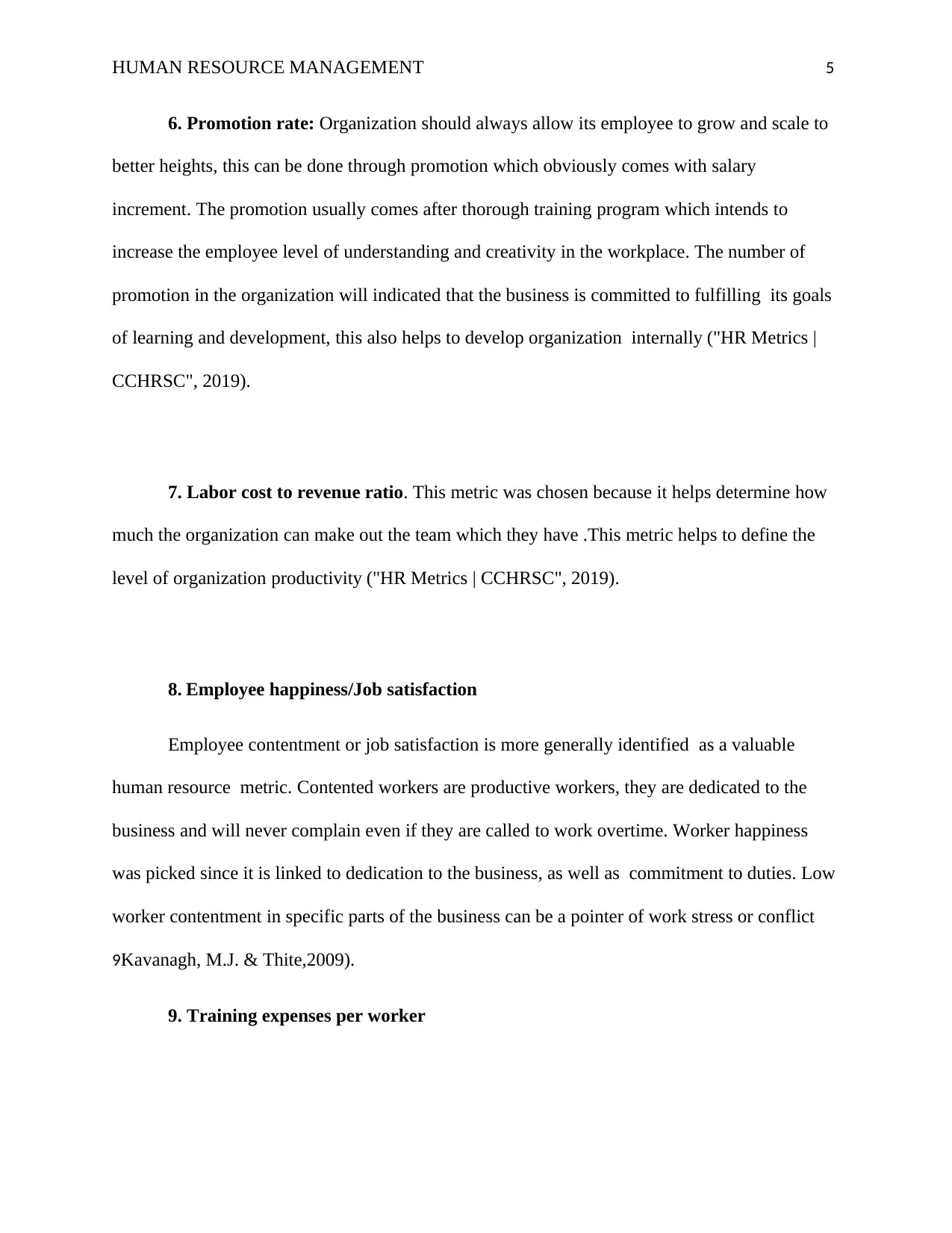
HUMAN RESOURCE MANAGEMENT 5
6. Promotion rate: Organization should always allow its employee to grow and scale to
better heights, this can be done through promotion which obviously comes with salary
increment. The promotion usually comes after thorough training program which intends to
increase the employee level of understanding and creativity in the workplace. The number of
promotion in the organization will indicated that the business is committed to fulfilling its goals
of learning and development, this also helps to develop organization internally ("HR Metrics |
CCHRSC", 2019).
7. Labor cost to revenue ratio. This metric was chosen because it helps determine how
much the organization can make out the team which they have .This metric helps to define the
level of organization productivity ("HR Metrics | CCHRSC", 2019).
8. Employee happiness/Job satisfaction
Employee contentment or job satisfaction is more generally identified as a valuable
human resource metric. Contented workers are productive workers, they are dedicated to the
business and will never complain even if they are called to work overtime. Worker happiness
was picked since it is linked to dedication to the business, as well as commitment to duties. Low
worker contentment in specific parts of the business can be a pointer of work stress or conflict
9Kavanagh, M.J. & Thite,2009).
9. Training expenses per worker
6. Promotion rate: Organization should always allow its employee to grow and scale to
better heights, this can be done through promotion which obviously comes with salary
increment. The promotion usually comes after thorough training program which intends to
increase the employee level of understanding and creativity in the workplace. The number of
promotion in the organization will indicated that the business is committed to fulfilling its goals
of learning and development, this also helps to develop organization internally ("HR Metrics |
CCHRSC", 2019).
7. Labor cost to revenue ratio. This metric was chosen because it helps determine how
much the organization can make out the team which they have .This metric helps to define the
level of organization productivity ("HR Metrics | CCHRSC", 2019).
8. Employee happiness/Job satisfaction
Employee contentment or job satisfaction is more generally identified as a valuable
human resource metric. Contented workers are productive workers, they are dedicated to the
business and will never complain even if they are called to work overtime. Worker happiness
was picked since it is linked to dedication to the business, as well as commitment to duties. Low
worker contentment in specific parts of the business can be a pointer of work stress or conflict
9Kavanagh, M.J. & Thite,2009).
9. Training expenses per worker
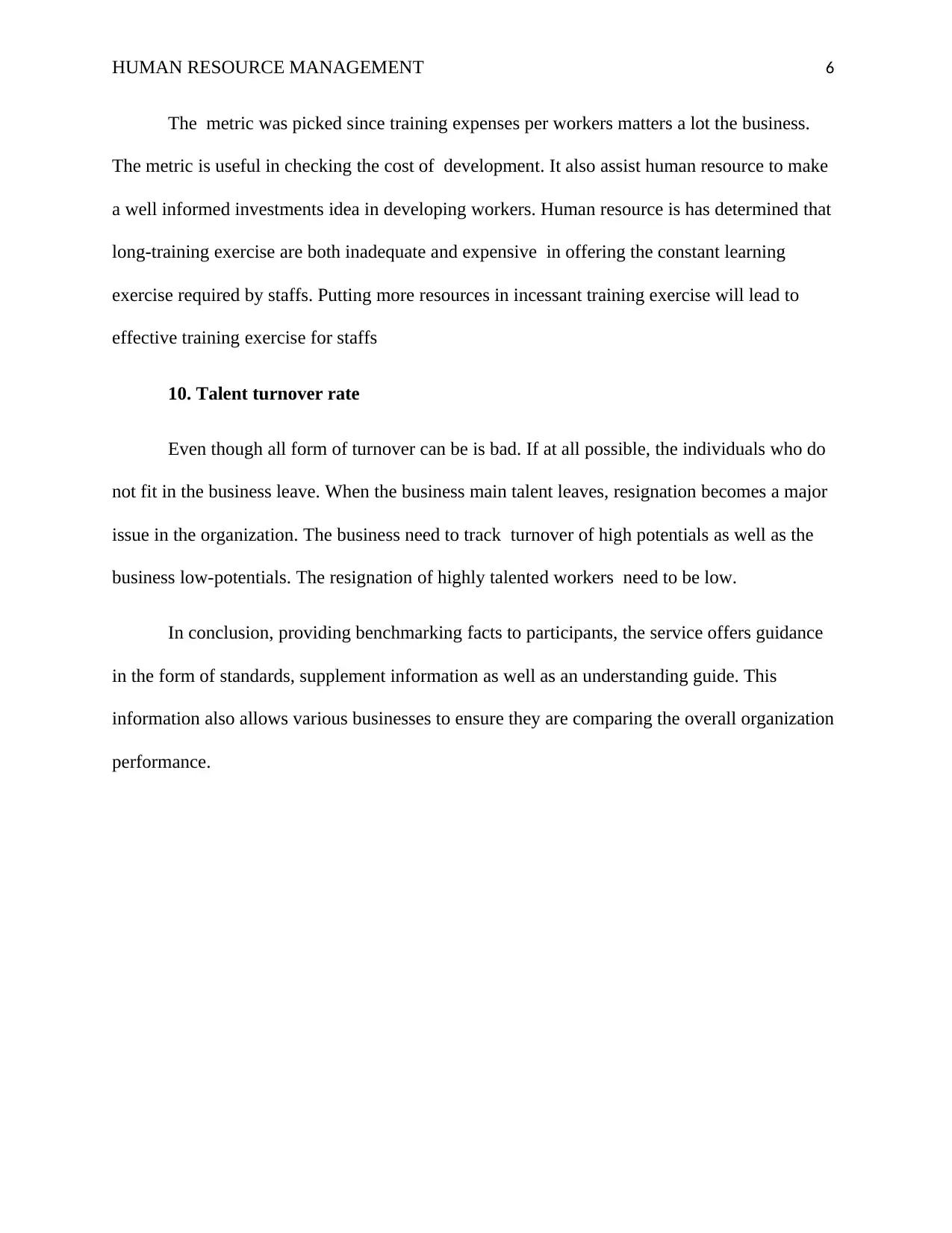
HUMAN RESOURCE MANAGEMENT 6
The metric was picked since training expenses per workers matters a lot the business.
The metric is useful in checking the cost of development. It also assist human resource to make
a well informed investments idea in developing workers. Human resource is has determined that
long-training exercise are both inadequate and expensive in offering the constant learning
exercise required by staffs. Putting more resources in incessant training exercise will lead to
effective training exercise for staffs
10. Talent turnover rate
Even though all form of turnover can be is bad. If at all possible, the individuals who do
not fit in the business leave. When the business main talent leaves, resignation becomes a major
issue in the organization. The business need to track turnover of high potentials as well as the
business low-potentials. The resignation of highly talented workers need to be low.
In conclusion, providing benchmarking facts to participants, the service offers guidance
in the form of standards, supplement information as well as an understanding guide. This
information also allows various businesses to ensure they are comparing the overall organization
performance.
The metric was picked since training expenses per workers matters a lot the business.
The metric is useful in checking the cost of development. It also assist human resource to make
a well informed investments idea in developing workers. Human resource is has determined that
long-training exercise are both inadequate and expensive in offering the constant learning
exercise required by staffs. Putting more resources in incessant training exercise will lead to
effective training exercise for staffs
10. Talent turnover rate
Even though all form of turnover can be is bad. If at all possible, the individuals who do
not fit in the business leave. When the business main talent leaves, resignation becomes a major
issue in the organization. The business need to track turnover of high potentials as well as the
business low-potentials. The resignation of highly talented workers need to be low.
In conclusion, providing benchmarking facts to participants, the service offers guidance
in the form of standards, supplement information as well as an understanding guide. This
information also allows various businesses to ensure they are comparing the overall organization
performance.
⊘ This is a preview!⊘
Do you want full access?
Subscribe today to unlock all pages.

Trusted by 1+ million students worldwide
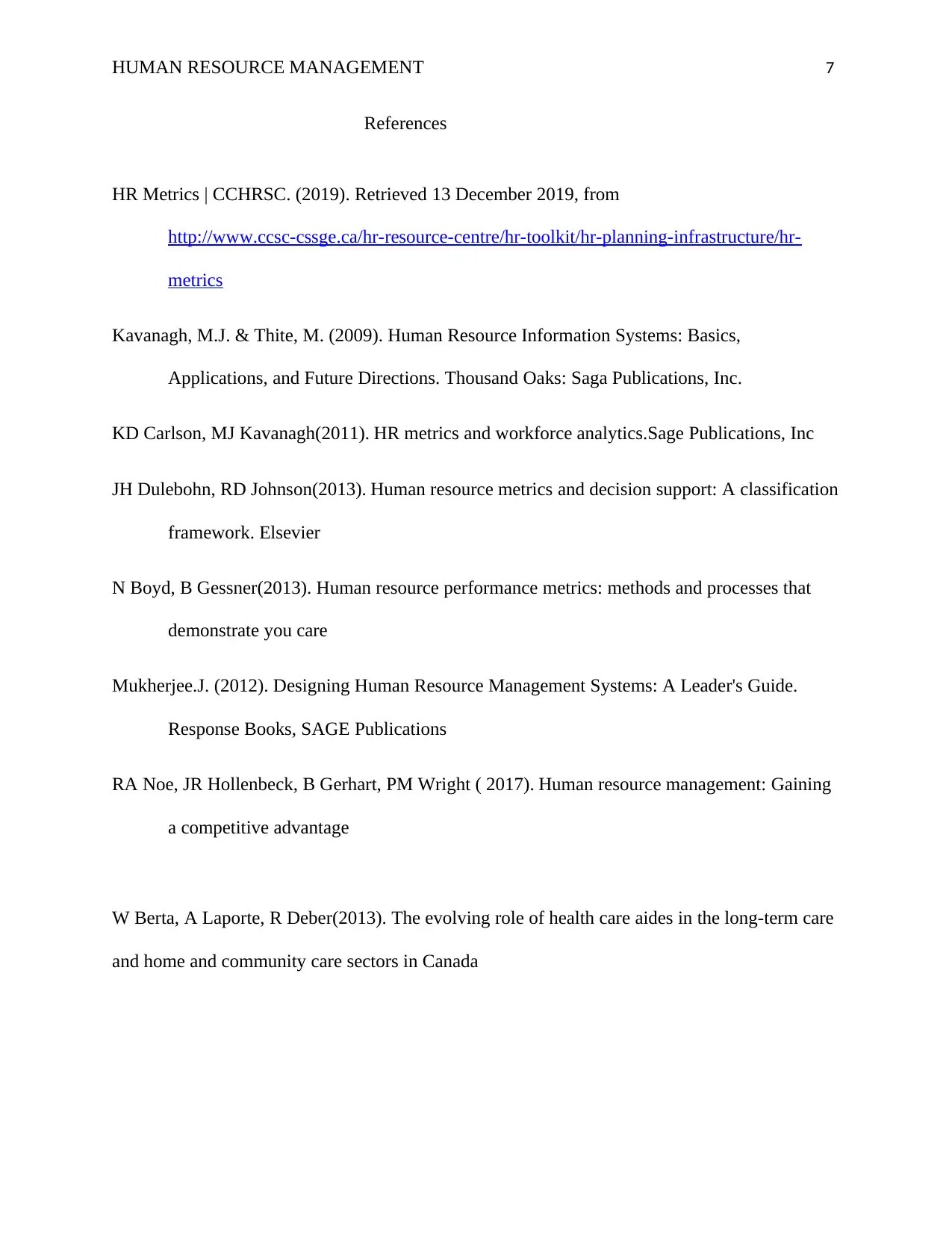
HUMAN RESOURCE MANAGEMENT 7
References
HR Metrics | CCHRSC. (2019). Retrieved 13 December 2019, from
http://www.ccsc-cssge.ca/hr-resource-centre/hr-toolkit/hr-planning-infrastructure/hr-
metrics
Kavanagh, M.J. & Thite, M. (2009). Human Resource Information Systems: Basics,
Applications, and Future Directions. Thousand Oaks: Saga Publications, Inc.
KD Carlson, MJ Kavanagh(2011). HR metrics and workforce analytics.Sage Publications, Inc
JH Dulebohn, RD Johnson(2013). Human resource metrics and decision support: A classification
framework. Elsevier
N Boyd, B Gessner(2013). Human resource performance metrics: methods and processes that
demonstrate you care
Mukherjee.J. (2012). Designing Human Resource Management Systems: A Leader's Guide.
Response Books, SAGE Publications
RA Noe, JR Hollenbeck, B Gerhart, PM Wright ( 2017). Human resource management: Gaining
a competitive advantage
W Berta, A Laporte, R Deber(2013). The evolving role of health care aides in the long-term care
and home and community care sectors in Canada
References
HR Metrics | CCHRSC. (2019). Retrieved 13 December 2019, from
http://www.ccsc-cssge.ca/hr-resource-centre/hr-toolkit/hr-planning-infrastructure/hr-
metrics
Kavanagh, M.J. & Thite, M. (2009). Human Resource Information Systems: Basics,
Applications, and Future Directions. Thousand Oaks: Saga Publications, Inc.
KD Carlson, MJ Kavanagh(2011). HR metrics and workforce analytics.Sage Publications, Inc
JH Dulebohn, RD Johnson(2013). Human resource metrics and decision support: A classification
framework. Elsevier
N Boyd, B Gessner(2013). Human resource performance metrics: methods and processes that
demonstrate you care
Mukherjee.J. (2012). Designing Human Resource Management Systems: A Leader's Guide.
Response Books, SAGE Publications
RA Noe, JR Hollenbeck, B Gerhart, PM Wright ( 2017). Human resource management: Gaining
a competitive advantage
W Berta, A Laporte, R Deber(2013). The evolving role of health care aides in the long-term care
and home and community care sectors in Canada
1 out of 7
Related Documents
Your All-in-One AI-Powered Toolkit for Academic Success.
+13062052269
info@desklib.com
Available 24*7 on WhatsApp / Email
![[object Object]](/_next/static/media/star-bottom.7253800d.svg)
Unlock your academic potential
Copyright © 2020–2025 A2Z Services. All Rights Reserved. Developed and managed by ZUCOL.
![5DVP: Developing Professional Practice Report - [University Name]](/_next/image/?url=https%3A%2F%2Fdesklib.com%2Fmedia%2Fimages%2Frq%2Fd1f1fed29d4c4b72b622be5f5f3b52cf.jpg&w=256&q=75)




